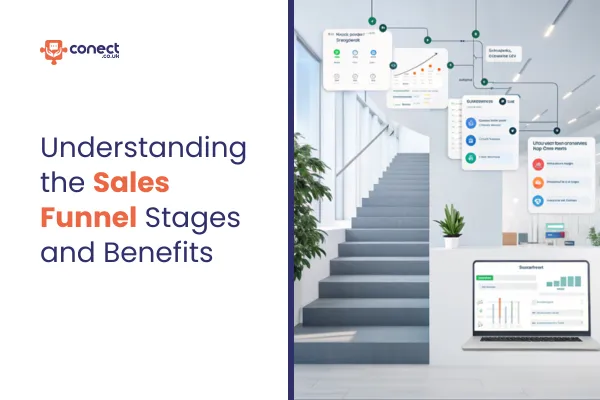
Sales Funnel Stages: A Simple Guide to Success
Mastering the Stages of a Sales Funnel for Maximum Conversions
Every business, whether big or small, strives to convert leads into loyal, paying customers. However, this process can sometimes feel like a maze without a clear strategy. This is where the sales funnel model comes in. By defining the journey a potential customer takes—from the moment they first hear about your brand to the final purchase and beyond—sales funnels can help businesses streamline their approach, ensuring that no lead is left behind.
Understanding the stages of a sales funnel is crucial for businesses seeking to enhance their marketing efforts and boost conversions. In this article, we will break down each of the stages of a sales funnel, explain their importance, and provide actionable strategies that you can implement to optimize your funnel and maximize sales. Let’s dive right in!
1. Awareness Stage: The Top of the Funnel
The Awareness Stage is the first phase in the sales funnel, and it’s all about making potential customers aware of your brand. At this stage, they might not even know your company exists or understand what you offer. The goal here is to get your brand in front of as many people as possible and introduce them to your products or services.
Most prospects first encounter your brand through online ads, search engine results, social media, word of mouth, or content like blog posts or podcasts. This is the stage where you capture the attention of a broad audience and begin the process of turning them into potential leads.
Key Action Points:
Content Marketing: Use blogs, podcasts, and videos to share valuable information that resonates with your target audience.
Search Engine Optimization (SEO): Implement SEO strategies to ensure that your brand appears in search results when potential customers are looking for solutions.
Social Media: Utilize social media platforms to share engaging and relevant content that can go viral and generate brand awareness.
In the Awareness Stage, the focus should be on creating content that solves problems or provides insights to make your audience aware of the solutions you offer.
2. Interest Stage: Building Engagement and Relationships
Once prospects are aware of your brand, they enter the Interest Stage, where they begin to engage with your content more seriously. They may follow your social media accounts, sign up for your newsletter, or download an ebook. This stage is about nurturing these early-stage leads and developing a relationship with them.
At this stage, it’s important to capture the prospect’s interest by providing them with content that’s more tailored to their needs. You want to keep them engaged, so they don’t forget about you as they move through the funnel.
Key Action Points:
Educational Content: Provide more in-depth content that dives deeper into your industry, products, or services. Case studies, white papers, and webinars work well.
Lead Magnets: Offer lead magnets such as free ebooks, templates, or checklists to encourage potential customers to take the next step.
Email Marketing: Use email campaigns to stay in touch with interested prospects, nurturing them toward the next stage.
The Interest Stage is crucial because it helps to build trust and demonstrates to potential customers that you understand their needs. Engaging content and personalized communication are key to maintaining momentum and advancing them to the next stage.
3. Decision Stage: Helping Prospects Choose You
In the Decision Stage, potential customers are actively considering a purchase. They’ve already researched their options and are weighing the pros and cons of different solutions. This stage is where your product or service needs to stand out from the competition.
Your goal in the Decision Stage is to convince prospects that your solution is the best choice for them. This is the time to address their concerns, show them the value of your offering, and provide them with strong reasons to move forward with you.
Key Action Points:
Customer Testimonials: Share testimonials, reviews, and case studies that show how your product or service has helped others.
Free Trials and Demos: Offer a free trial or demo of your product to let prospects experience its value firsthand.
Clear Calls-to-Action (CTAs): Use compelling CTAs that encourage prospects to take the next step, such as scheduling a demo or making a purchase.
The Decision Stage is where the magic happens. It’s your chance to guide the prospect through any last-minute concerns they may have and push them toward making a purchase.
4. Action Stage: Converting Leads Into Paying Customers
The Action Stage is where the lead becomes a customer. This is the final step of the sales funnel, where all your efforts culminate in a purchase. At this point, the prospect is ready to take action and buy your product or service. This is the stage where all your hard work finally pays off.
However, the conversion isn’t always guaranteed. It’s essential to make the process as smooth as possible and remove any potential obstacles that could cause the customer to hesitate or abandon the purchase.
Key Action Points:
Optimized Checkout Process: Ensure that the purchasing process is as simple and seamless as possible. Remove unnecessary steps and ensure the user experience is smooth.
Post-Purchase Follow-Up: After a customer makes a purchase, follow up with a thank-you message, confirmation email, or an invitation to reach out for support if needed.
Customer Support: Offer excellent customer service to address any concerns or questions the customer might have, even after they’ve made the purchase.
The Action Stage is where you turn a lead into a customer, but your job doesn’t end there. Follow-through and support play an important role in customer satisfaction and retention.
5. Retention Stage: Turning Customers Into Loyal Advocates
After a customer makes a purchase, your work isn’t finished. Retention is one of the most important stages of the sales funnel. Retaining existing customers is more cost-effective than acquiring new ones, and happy customers are likely to make repeat purchases and refer others to your business.
This stage is about keeping your customers happy and engaged with your brand so they continue to return. If you manage to keep your customers satisfied, they’ll not only keep buying from you but also become advocates for your brand, recommending it to others.
Key Action Points:
Customer Loyalty Programs: Offer incentives for repeat purchases, such as discounts, loyalty points, or exclusive offers.
Customer Engagement: Keep customers engaged through regular communication, including emails, newsletters, or special promotions.
Feedback: Actively seek feedback from your customers to identify areas for improvement and to show that you care about their experience.
The Retention Stage is about building long-term relationships with customers, ensuring they remain loyal, and encouraging them to spread the word about your business.
6. Improving the Efficiency of Your Funnel
Optimizing each stage of the sales funnel ensures that prospects are guided smoothly from one step to the next. By continuously analyzing your funnel’s performance, you can identify weak spots and make necessary adjustments to increase conversion rates. Simple tactics like improving the user experience on your website or refining your messaging can have a significant impact.
7. Personalizing the Sales Funnel Experience
Personalization plays a key role in guiding prospects through the funnel. By tailoring content and offers to meet the specific needs and interests of your audience, you can create a more engaging experience. Using data and insights from your interactions with customers, you can personalize emails, offers, and recommendations, which will ultimately lead to higher conversions and customer loyalty.
FAQs
1. What is the first step in the sales process?
The first step is creating awareness about your brand and its offerings. This helps attract potential customers who may not be familiar with your business.
2. How do you engage prospects during the early stages?
Engagement begins by providing valuable content, like blog posts or webinars, that addresses the needs of your target audience. This helps build a relationship with them.
3. How can I convince leads to make a purchase?
To convince leads, use testimonials, case studies, and free trials to build trust. Make sure to highlight the value and benefits of your product or service.
4. What happens after a lead makes a purchase?
After a purchase, follow up with excellent customer service and ensure a smooth experience. Offering post-purchase support helps retain customers for future business.
5. How do I keep my customers coming back?
You can retain customers by providing excellent service, offering loyalty programs, and engaging them with regular updates and promotions. Happy customers are likely to return.
Conclusion
To wrap things up, understanding and optimizing the stages of a sales funnel is essential for driving higher conversion rates and ensuring long-term business growth. From attracting awareness to retaining loyal customers, each stage plays a vital role in guiding prospects through their journey and ultimately converting them into paying customers.
By focusing on each stage—Awareness, Interest, Decision, Action, and Retention—you can develop a strategic approach to growing your business, improving customer engagement, and ultimately boosting your sales. So, take the time to refine your sales funnel, and you’ll soon see the positive impact on your bottom line.

The All-In-One Solution to grow your business. Capture Free Leads And Conversationally Covert Them Into Customers!
Contact information
Address : Layton Lane, Rawdon, Leeds, LS19 6RG
Phone : +44 7859 775480
Email : [email protected]
© 2025 Butterfly Effect Marketing Ltd - All Rights Reserved.

